No products in the cart.
One hand Pinch
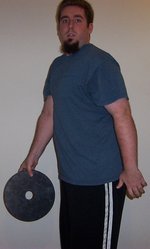
The one hand pinch is an excellent exercise for statically working the pinch grip and strengthening the thumbs. To perform this exercise, sandwich two plates together (smooth side out) and stand them on edge. Grasp over the top of the plates with one hand, placing the fingers on one side of the plates, the thumb on the other. Squeeze as hard as possible and attempt to lift the plates off the ground.
To perform well on this exercise, it is important to be sure the hands are well chalked. Initially, the webbing between the pointer finger and thumb may be damaged during the plate pinch. Allowed to heal, the skin will become tougher and ultimately stand up to the stress with little problem. Many find training the plate pinch with two hands on the plates at once to be key to developing a strong one handed pinch.
Pinching 2 25lb plates should be a readily obtainable goal for most. Working up to 2 35lb plates is more challenging. Progressive resistance can be obtained by running a piece of 1.5” inner diameter pipe through 2 olympic plates and adding weight as needed. One can also make the plate pinch work more challenging by doing timed holds or passing the plates from hand to hand. Note that these exercises are more likely to cause trauma to the thumb webbing than simply deadlifting the plates and setting them back down.
Two Hand Pinch
Two hand pinch is done in a similar fashion as one hand pinch. The weight is lifted with the palms facing the body. To reach greater poundages, attempt to curl the weight up between the thighs while performing the lift.
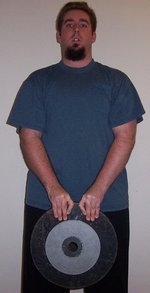
Finger Press
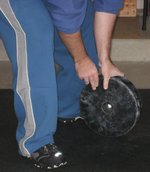
The strength needed to break a weight off the ground is greater than the strength needed to hold it or control its decent. The finger press is a technique to take advantage of this fact. When training a pinch lift with one hand, apply slight pressure on the thumb side of the equipment to assist in raising a heavier than normal load. Then remove the off hand, allowing for a timed hold or negative.
In addition to training the grip, this tool is helpful for overcoming mental blocks with a specific weight. Once the mind knows a weight can be controlled, breaking it off the ground becomes much easier. Also consider using the finger press on fixed size thick dumbbells. Slight pressure applied to the head of the weight will stop rotation and enable a stronger pull.
Loadable Plate Pinch
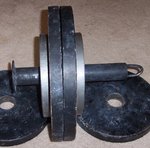
Pass a loading pin or piece of pipe through 2 35lb plates to make a loadable plate pinch. This tool can be used to train one and two hand pinching with progressive resistance. The bar between the plates prevents them from slipping, making it easier to lift a given weight.
Block Weight
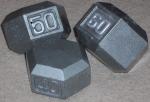
Large metal block (typically the head off of a dumbell), used to work the hand in the open position. Blocks range in weight from 20 to 50lbs. They can be deadlifted, carried, or even tossed from hand to hand. These are one of the cheapest and most effective grip tools. Used dumbells can be purchased for around 30 cents a lb. A hacksaw with 18 teeth per inch and some 3 in 1 oil can get the heads off a dumbell in about 30 minutes. Power tools make the job a lot easier.
Block Weight Exercises
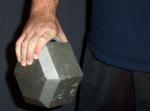
Block weight work stresses the entire hand, bringing together all aspects of grip strength into highly functional movements. Most find they prefer to place block weight work at the end of their grip workouts, to avoid limiting performance on other exercises. A wide range of exercises can done using a single block weight. Here are a number of them, listed in order of easiest to hardest. Unless otherwise stated, a pinch grip over the narrowest part of the block is used, with chalk. A 25lb block is a good starting point for most when working through this list.
- Underhand toss from hand to hand
- Assisted lift to an attempted hold
- Lockout from bench
- Deadlift from ground
- Pass from hand to hand
- Clean and press it
- Snatch it
- Curl it
- Toss from hand to hand
- Release and catch with one hand
- Toss so it flips over once, catch with opposite hand
- Toss so it flips over once, catch with same hand
Progress can be tested by hanging additional weight off the block and working up to a max deadlift from the ground. Note that because the heavier blocks are also wider, lifting a 25lb block with 5lbs attached is not as hard as lifting a 30lb block. Weight can be attached by draping a piece of strong cord with plates tied to either end over the top of the block. An extremely strong magnet or magnetic weights can also be used.
Depending on the size of the block weight, performing the exercises above may also be possible while grasping the block across its widest point. Care must be taken to break into this type of training slowly. The extremely wide grip may hyperextend the thumb, causing a tendon injury that is slow to heal.
Pinch Machine

Plate loaded machines can be used to train dynamic and static pinch strength. The simplest design is a lever on a base, with the weight at one end and flat plates at the other. Used with one or two hands, the loadable lever design allows for a range of training options.
Pony Clamp

Pony clamps provide a low cost alternative to plate loaded pinch machines. With slight modifications one can also be used to train two handed static and dynamic pinches.
Hub Lift
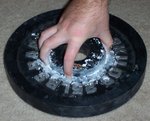
Place an olympic plate face side up. Grasp the hub in the center with finger tips. Squeeze hard and lift the plate. A very strong man can lift a 45lb plate in this fashion. Companies like Ironmind also produce a stand alone hub device that can be used with a loading pin for training this lift.
Olympic weight plates
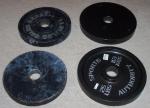
Olympic plates are one of the most readily accessible tools for grip training. In addition to providing resistance on equipment, they can be used directly for a number of grip exercises. Some of the most basic include plate pinches, hub lifts, plate curls, and plate wrist curls. Factors to take into consideration when selecting plates for grip work are as follows:
- Plate finish – Plates with a slick glossy finish will be very difficult to pinch or hub lift. A flat, non-glossy finish is highly desirable in plates that will be used for grip work. Some people even prefer plates with a little rust on them to provide texture.
- Plate diameter – The larger the plate diameter, the harder it will be to plate curl or plate wrist curl
- Plate thickness – The thicker the plate, the wider the pinching width. The pinch width that one will perform best with varies by person.
- Hub width, depth, and shape – Plate hubs vary considerably. Plates with deep narrow hubs that sit flush with the plate face will be much easier to hub lift than those with shallow wide hubs that have a visible taper into the plate face.
Also note that one style of olympic plate is entirely symmetrical, with matching ridges on the front and back rim, as well as handles cast into the plate. Often found at fitness gyms, these work poorly for plate pinches or hub lifts.
